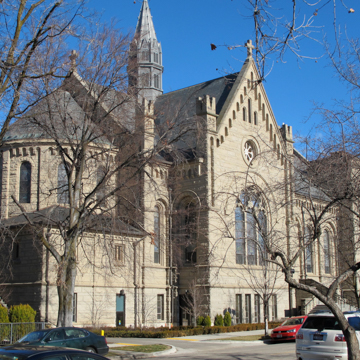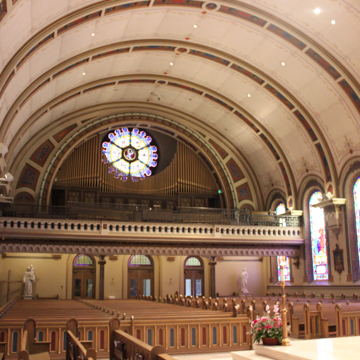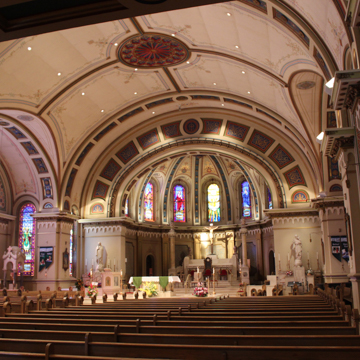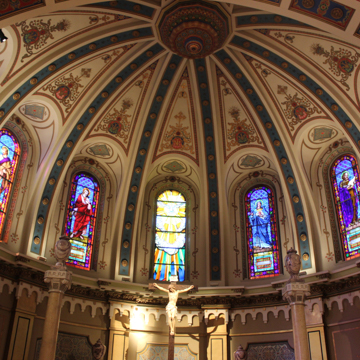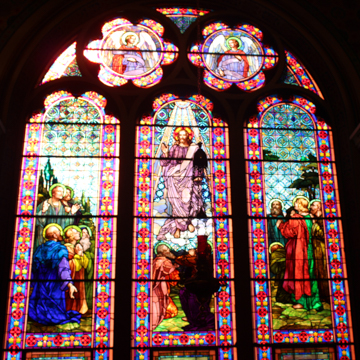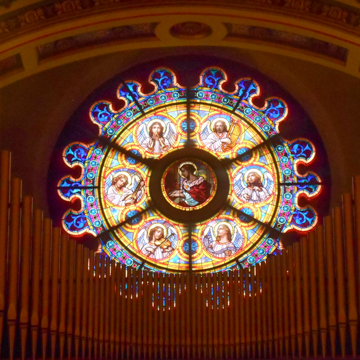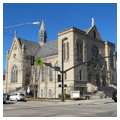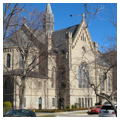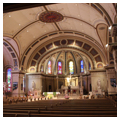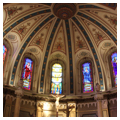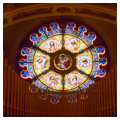A decade and a half after Idaho’s 1890 statehood, Boise’s rapid growth necessitated an increase of civic buildings in the state’s capital city. During this period, Idaho’s premier architectural firm began work on two large institutional buildings that forged the city’s image as government and cultural center: the State Capitol Building in 1905 and the Cathedral of St. John’s in 1906. As the most visible symbol for the Catholic Diocese of Idaho, the cathedral is a spiritual counterbalance to the secular, classical capitol building visible a few blocks south. The Romanesque Revival cathedral is a concert of stained glass, light, color, rare materials, and ornament that celebrates the strength of the Catholic faith.
In 1893 Boise’s Catholic population reached 7,000, warranting diocesan status. Bishop Glorieux established the Diocese of Boise under Pope Leo XIII, and “envisioned a cathedral dedicated to St. John the Evangelist.” When funds were secured, he hired parishioner Charles F. Hummel of Tourtellotte and Hummel to design the cathedral. The cathedral’s cornerstone was laid in 1906 and construction continued in stages over a fifteen year period. With no alternative place to worship, mass continued to be held within the partially completed cathedral throughout construction, allowing the Diocese to stay solvent and avoid incurring debt. Bishop Glorieux died in 1917 and his successor, Bishop Daniel Gorman, more comfortable with debt, accelerated the cathedral’s completion.
The church is constructed of local sandstone from the nearby Table Rock Quarry. Hummel based his design on the Romanesque Cathedral of Mainz in Germany, where he grew up, as well as St. Sernin in Toulouse, France, as a secondary source of inspiration. The design, as first presented, included a pair of towers making the church appear tall and slender. Because the towers were never completed, the cathedral has a bulkier appearance not unsuitable for its Romanesque Revival styling. The church’s large and blocky sandstone exterior and its first-story Romanesque entry arches establish the church’s character. The stonework is left rough with refined ashlar joinery and finely cut upper window trefoil ornament. The front facade’s focal point is a large twelve-foot rose window articulated by six spokes. The window ensemble rests on nine equally spaced Tuscan columns set within a false recessed window. On the interior, the rose window, which illuminates the upper choir, reveals itself more clearly as a stained glass window depicting Saint Cecilia, patron saint of musicians, who is surrounded by six angels playing musical instruments. On the exterior the window assembly floats above three repeating Romanesque arched entries. Above the window rises the main roof center gable with Saint John the Evangelist at its peak.
The cathedral shines most brilliantly inside. It is here that the Romanesque style comes alive in a concert of colored light and ornamental elements of richly veined Italian marbles, tilework, gilded ornament, and wall paintings. With seating for 1,000 worshippers, St. John’s is one of the largest worship spaces in the state; its cruciform plan measures 170 feet long by 65 feet wide. The organ consists of 43 ranks, the equivalent to 3,000 pipes, which makes it one of the largest in Idaho. The barrel vaulted ceiling is structurally false and functions as an acoustic canvas to enhance the choir music.
St. John’s has beautiful stained glass windows depicting the life of Christ, the four gospel writers, and four saints. The figures are painted in a realistic style and were installed in one piece by the John Kinsella Glass Company of Chicago; this was innovative at the time because typically each color of stained glass would be installed separately. Additionally, the stained glass is thickly leaded and not common for the era. Charles Hummel II, grandson of the architect, notes that, “what is remarkable [about the windows] are the painted parts are only reserved for faces and hands.” Furthermore, he explains that four saints depicted in the windows have particular significance to Boise: St. Rita represents the eponymous society that played an active cultural role in Boise at the time; St. Patrick pays tribute to the first Catholic Church in Boise; the first Catholic hospital in Idaho was named St. Alphonsus; and St. Theresa represents Boise’s first Catholic academy (now Bishop Kelly High School).
In response to the Vatican Council II reforms of the 1960s, a committee composed of Charles Hummel II, architect grandson of the original designer, Father Tom Faucher, a parish priest and liturgical expert, and Robert Rambusch, a New York specialist in church interiors, proposed a remodeling program to meet the new liturgical guidelines. The committee also proposed a thorough cleaning: because of the original coal furnace and candle chandeliers, a significant amount of soot covered the interior and exterior of the Cathedral. With a budget of $351,423, renovations began on Easter Monday 1979 and were on a strict schedule to be completed six months later. The most visible change was in the lighting as the candle chandeliers were replaced by soft uplights on the cornices. Removing 50 years of soot from the decorated canvas ceiling revealed its original bright colors, and interior walls were painted a lighter color, brightening the entire space.
A key addition during the Vatican II remodeling is the Holy Spirit stained glass window in the center of the apse. Though part of the Cathedral’s initial design, the back of the main altar would have hidden the window so it was never installed. Added in 1979, modeled after a window in St. Peter’s Basilica in Rome and produced by the Rambusch Company, it is the only modern stained glass in the Cathedral.
The latest restoration of St. John’s commenced on the cathedral’s 100-year anniversary and focused primarily on landscaping and the basement, where the chapel and parish hall are located. The architects, Rob Thornton and Russ Philips, transformed the chapel into a 24-hour adoration chapel accessed separately from the cathedral. The remodel included new marble floors, pews, altar, and exposed the original sandstone walls.
After two renovations, St. John’s has retained its original style and use. Its intricate Romanesque architecture is so admired that there are weekly tours meet a curious public’s demand to know more about the building. Today, the state’s oldest firm, Hummel Architects, still displays the cathedral on its website as one of its proudest legacies.
References
Cathedral of St. John the Evangelist. “History of the Cathedral.” Accessed October 15, 2014. http://boisecathedral.org/67.
Cheney, David. “Diocese of Boise City.” Catholic-Hierarchy. Accessed October 16, 2014. http://www.catholic-hierarchy.org/diocese/dbois.html.
Cooper, Suzette. Interview by Natalie Hickman. Boise, ID, October 19, 2014.
“History of the Diocese of Boise.” Roman Catholic Diocese of Boise. Accessed October 16, 2014. http://www.catholicidaho.org/History.
Hummel, Charles. “Cathedral of Saint John the Evangelist: Construction History, Architecture, Liturgical Art, and Decoration.” Idaho, 2007.
Hummel, Charles. Interview by Natalie Hickman. Boise, ID, November 24, 2014.
Stan Wiens, Doug. “St. John’s Cathedral.” Boise Architecture Project. Accessed October 21, 2014. http://boisearchitecture.org/structuredetail.php?id=221.
Webb, Anna. “Top 50 Stories: 1900-1950—Tourtellotte and Hummel.” Idaho Statesman(Boise), June 21, 2014.


